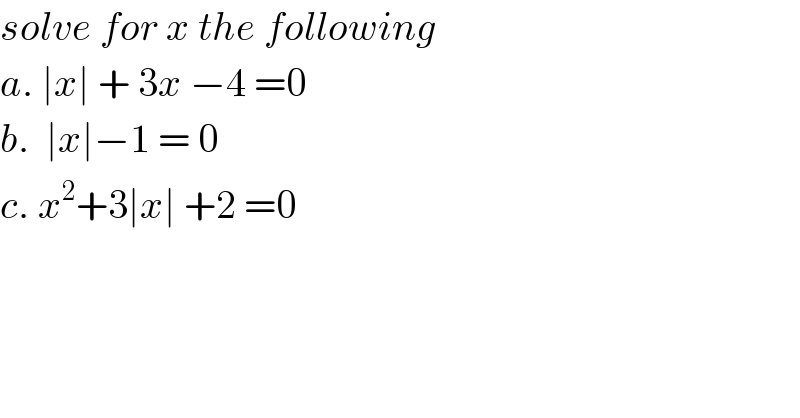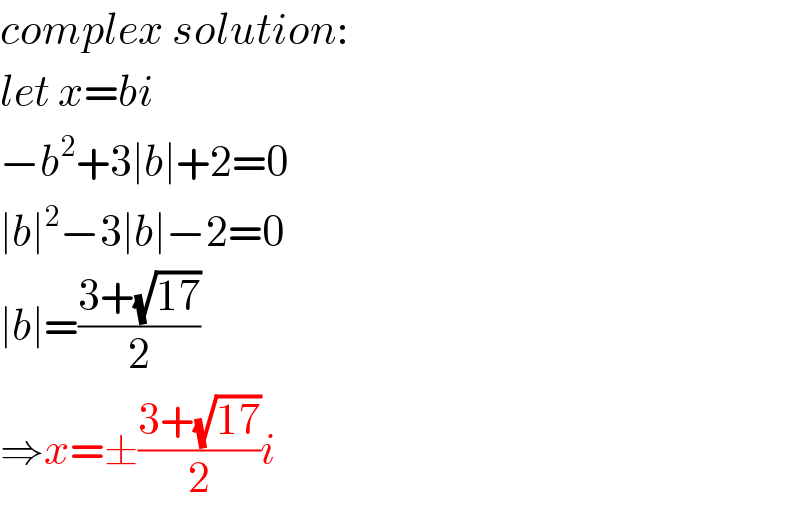
Question Number 75932 by Rio Michael last updated on 21/Dec/19

$${solve}\:{for}\:{x}\:{the}\:{following} \\ $$$${a}.\:\mid{x}\mid\:+\:\mathrm{3}{x}\:−\mathrm{4}\:=\mathrm{0} \\ $$$${b}.\:\:\mid{x}\mid−\mathrm{1}\:=\:\mathrm{0} \\ $$$${c}.\:{x}^{\mathrm{2}} +\mathrm{3}\mid{x}\mid\:+\mathrm{2}\:=\mathrm{0} \\ $$$$ \\ $$
Commented by mathmax by abdo last updated on 21/Dec/19

$$\left.{c}\right)\:\:{x}^{\mathrm{2}} \:+\mathrm{3}\mid{x}\mid+\mathrm{2}\:=\mathrm{0}\:\Leftrightarrow\:\mid{x}\mid^{\mathrm{2}} +\mathrm{3}\mid{x}\mid+\mathrm{2}=\mathrm{0}\:\Rightarrow{t}^{\mathrm{2}} \:+\mathrm{3}{t}\:+\mathrm{2}=\mathrm{0}\:{whit}\:{t}=\mid{x}\mid \\ $$$${so}\:{t}\:{must}\:{be}\:\geqslant\mathrm{0}\:\:\Delta=\mathrm{3}^{\mathrm{2}} −\mathrm{4}.\mathrm{2}\:=\mathrm{1}\:\Rightarrow{t}_{\mathrm{1}} =\frac{−\mathrm{3}+\mathrm{1}}{\mathrm{2}}\:=−\mathrm{1} \\ $$$${t}_{\mathrm{2}} =\frac{−\mathrm{3}−\mathrm{1}}{\mathrm{2}}\:=−\mathrm{2}\:\:{all}\:{values}\:{of}\:{t}\:{are}\:<\mathrm{0}\:\Rightarrow\:{no}\:{solutions}.. \\ $$
Answered by benjo last updated on 21/Dec/19

Commented by Rio Michael last updated on 21/Dec/19

$${why}\:{sir} \\ $$
Commented by mr W last updated on 22/Dec/19

$${x}^{\mathrm{2}} \geqslant\mathrm{0} \\ $$$$\mid{x}\mid\geqslant\mathrm{0} \\ $$$${x}^{\mathrm{2}} +\mathrm{3}\mid{x}\mid+\mathrm{2}\geqslant\mathrm{2} \\ $$$${therefore}\:{x}^{\mathrm{2}} +\mathrm{3}\mid{x}\mid+\mathrm{2}=\mathrm{0}\:{is}\:{impossible}. \\ $$$${i}.{e}.\:{x}^{\mathrm{2}} +\mathrm{3}\mid{x}\mid+\mathrm{2}=\mathrm{0}\:{has}\:{no}\:\left({real}\right) \\ $$$${solution}. \\ $$
Commented by benjo last updated on 24/Dec/19

$$\mathrm{how}\:\mathrm{about}\:\mathrm{in}\:\mathrm{complex}\:\mathrm{solution}\:\mathrm{sir}? \\ $$
Commented by mr W last updated on 24/Dec/19

$${complex}\:{solution}: \\ $$$${let}\:{x}={bi} \\ $$$$−{b}^{\mathrm{2}} +\mathrm{3}\mid{b}\mid+\mathrm{2}=\mathrm{0} \\ $$$$\mid{b}\mid^{\mathrm{2}} −\mathrm{3}\mid{b}\mid−\mathrm{2}=\mathrm{0} \\ $$$$\mid{b}\mid=\frac{\mathrm{3}+\sqrt{\mathrm{17}}}{\mathrm{2}} \\ $$$$\Rightarrow{x}=\pm\frac{\mathrm{3}+\sqrt{\mathrm{17}}}{\mathrm{2}}{i} \\ $$
Commented by benjo last updated on 24/Dec/19

$$\mathrm{thanks}\:\mathrm{you}\:\mathrm{sir} \\ $$
